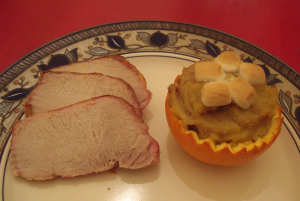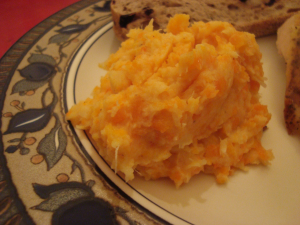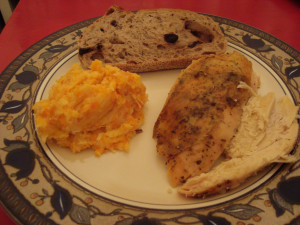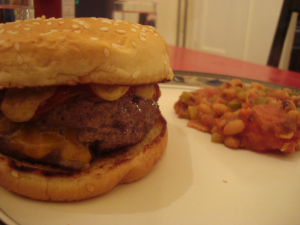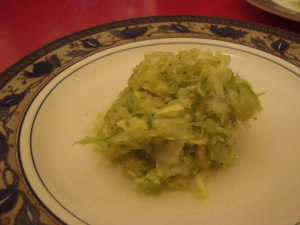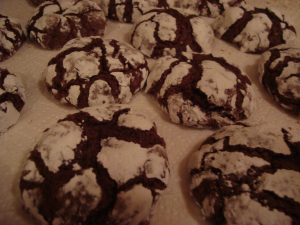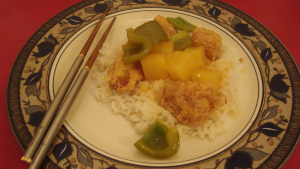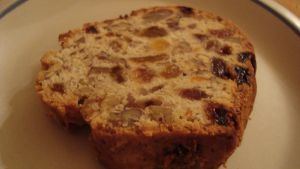 I’ve had Women of Great Taste, published by the Junior League of Wichita, Kansas (1995), for ages now, but just didn’t quite know what to make of it. For starters, there’s the theme, which is a good idea, but plays out sort of… strangely. Each chapter begins with a clever illustration of a famous woman, tied loosely to the theme of the section. Carry Nation (the only native Kansan of the bunch) for Appetizers and Beverages makes sense, as does Marie Antoinette for Desserts. Though it’s a stretch, I’ll buy Carmen Miranda for the Soups and Salads section, but the illustration of Joan of Arc wielding a kabob for the Meats section might be considered in slightly poor taste.
I’ve had Women of Great Taste, published by the Junior League of Wichita, Kansas (1995), for ages now, but just didn’t quite know what to make of it. For starters, there’s the theme, which is a good idea, but plays out sort of… strangely. Each chapter begins with a clever illustration of a famous woman, tied loosely to the theme of the section. Carry Nation (the only native Kansan of the bunch) for Appetizers and Beverages makes sense, as does Marie Antoinette for Desserts. Though it’s a stretch, I’ll buy Carmen Miranda for the Soups and Salads section, but the illustration of Joan of Arc wielding a kabob for the Meats section might be considered in slightly poor taste.
However, the recipes themselves are anything but. Forget everything you think you know about Kansan cuisine because the dishes included in this cookbook don’t seem like anything that might have come out of Auntie Em’s kitchen. Sure, there’s some comfort food here, but for the most part, the dishes are light, elegant, seasonal, and many include international flavors and ingredients. In the end, it was tough to pick what to make, but since I vowed to make one meal that didn’t call for massive gobs of butter, and since I felt like baking bread, things fell into place from there.

This particular bread recipe appealed to me because there are two beekeepers in my family, so we currently have a ton of wildflower and buckwheat honey (fun fact: when bees make honey from the pollen and nectar of buckwheat, it turns out a dark purplish-red).
Liberty Loaves
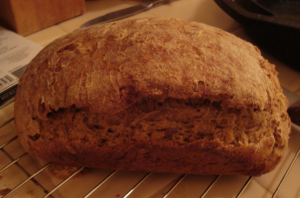
Liberty Loaves
2 cups water
1 cup rolled oats
1/2 cup honey
1 T. butter
2 t. salt
1 cup roasted sunflower kernels (optional)
1 package active dry yeast
1/2 cup warm water (110 to 115 degrees)
2 1/2 cups whole-wheat flour
2 cups bread flour
Bring water to a boil and stir in oats. Set aside for 1 hour. Oil two 9 x 5 x 3-inch loaf pans and a large mixing bowl. Add honey, butter, salt and sunflower kernels to oat mixture and stir well. Dissolve yeast in warm water and allow to stand for 5 minutes. Stir softened yeast into oat mixture. Blend in flours until dough pulls cleanly away from sides of bowl. Form dough into a ball and place in prepared bowl, turning to coat entire surface. Cover loosely with plastic wrap and a kitchen towl. Let rise in a warm draft-free area for 1 hour or until double in size. Punch down dough to remove air bubbles, then knead until smooth and elastic. Divide into two loaves and place in prepared pans. Cover and let rise again until double in size.

Preheat oven to 350 degrees. Bake until bread sounds hollow when tapped on bottom, 50 minutes. After baking for 35 minutes it may be necessary to shield loaves with foil to prevent over-browning. Remove bread from pans immediately and cool on a wire rack.
Yield: 2 loaves
I was really concerned about how this bread would turn out because it didn’t rise to anything close to double in size, though I was careful about temperature. Brady theorized that between the heavy oats, whole-wheat flour, sunflower seeds, and honey, the yeast just got tired. Whether or not this was the case, however, this is a delicious bread recipe, moist, nutty, wholesome, and just a little bit sweet. I had some this morning for breakfast, toasted with butter and honey, and it was heavenly. I know it says the sunflower kernels are optional, but don’t you dare leave them out.
Running butter tally: 1 tablespoon
For the main course, I chose this butternut and shallot risotto. I don’t quite know what a shallot is, or how it’s related to or different from an onion, but I do know that the presence of shallots in a recipe improves the likelihood of its deliciousness by at least 25%. Unless it’s dessert.
Butternut Risotto

Butternut Risotto
1 medium butternut squash
2 T. unsalted butter, divided
1 T. olive oil
4 shallots, minced
2 cups Arborio rice
1/2 cup dry white wine
5 to 6 cups chicken broth, heated
Freshly grated nutmeg, to taste
Salt and freshly ground pepper, to taste
1 T. minced fresh rosemary
1/2 cup freshly grated Parmesan cheese, divided
Rosemary sprigs for garnish
Cut squash into eighths, discarding seeds. Steam until fork tender. Scoop squash from skin and lightly mash. Melt 1 tablespoon butter in saucepan, add oil and saute shallots for 2 minutes. Add rice and cook for 5 minutes, stirring often. Add wine and continue cooking until liquid is nearly absorbed. Add squash and 1 cup heated chicken broth. Simmer until liquid is nearly absorbed. Continue stirring in broth one ladle at a time until rice is creamy and firm, 15 to 20 minutes. Season with nutmeg, salt and pepper. Stir in rosemary, remaining butter and 1/4 cup cheese. Serve in shallow bowls garnished with remaining cheese and rosemary sprigs.
Yield: 4-6 servings
I’ve made adequate risotto, flavorless, mushy risotto, and one really excellent risotto, and what seems to make all the difference is (gasp) really following the directions. This one was really tasty (though it can’t really compete with that sublime bacon and egg recipe I linked to), and the flavor combination of fresh rosemary, butternut squash and nutmeg works amazingly well.
Running butter tally: 3 tablespoons
For side dishes, I decided to go with two vegetable dishes, and chose the first because I’d never braised fennel before, or for that matter, done much of anything with fennel before. It’s a crazy-looking vegetable, kind of a cross between an onion, a bunch of celery, and dill, and it tastes a little bit like anise.
Braised Fennel

Braised Fennel
4 medium fennel bulbs
1 1/2 T. unsalted butter
1 t. granulated sugar
2 cloves garlic, thinly sliced
1/4 cup fresh orange juice
1 cup water
Salt, and freshly ground pepper, to taste
1/2 cup fresh parsley leaves
Trim tops off fennel, then cut each bulb in half lengthwise. Melt butter in a large skillet and stir in sugar until dissolved. Add garlic and saute for 2 minutes. Place fennel in skillet, cut side down, cooking until well browned, 5 to 10 minutes. Turn fennel and add orange juice, water, salt and pepper. Bring to a boil, reduce heat and cover. Simmer until fennel is fork tender, 20 to 30 minutes. (If pan becomes dry during cooking, add a little more water.) Continue to cook uncovered at medium heat until liquid evaporates. Toss with parsley and serve immediately.
Yield: 8 servings
This one got mixed reviews. I thought it was quite nice, but there was some note in the flavor that Brady didn’t like at all, and that he swears was not anise. Also, for something braised, it is very attractive. Usually braising will knock the pretty right out of food.
Running butter tally: 4 1/2 tablespoons
And speaking of pretty, here’s the last Wichita dish. It’s beyond easy, but there were heirloom cherry tomatoes at the grocery store, and I couldn’t resist. I doubt I even need to tell you how good it tastes because a) so luminously pretty, and b) shallots!
Herbed Cherry Tomatoes

Herbed Cherry Tomatoes
2 shallots, minced
4 green onions, thinly sliced
2 T. minced fresh parsley
1 t. dried dill weed
1/4 cup butter
3 cups cherry tomatoes
1/2 t. salt
Saute shallots, onions, parsley and dill in butter until tender. Add tomatoes and salt. Cook, stirring gently until a few tomato skins burst, 5 to 7 minutes. Tomatoes should be well coated with butter-herb mixture.
Yield: 6 servings
Running butter tally: 8 1/2 tablespoons
Alas, it seems that I have still managed to go over one stick of butter, despite my best efforts; however, as it is only by a half tablespoon and we did get two suppers, a breakfast, and a couple of lunches out of this meal, I will not lose too much sleep over it.
Next up: either Washington state or Washington, D.C., I have not decided which, but either way, there will probably be fish.






